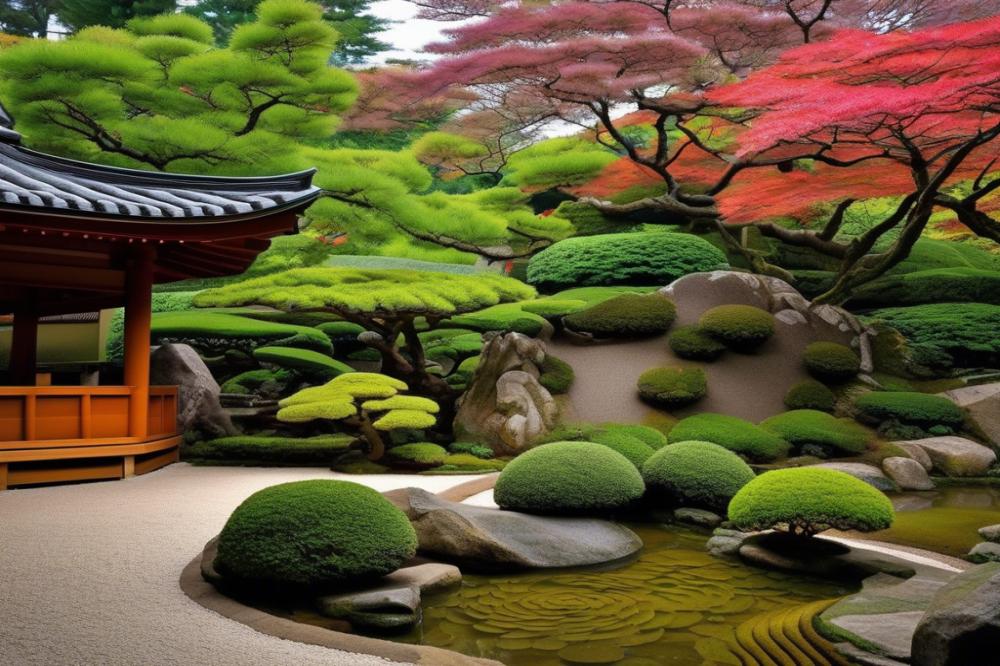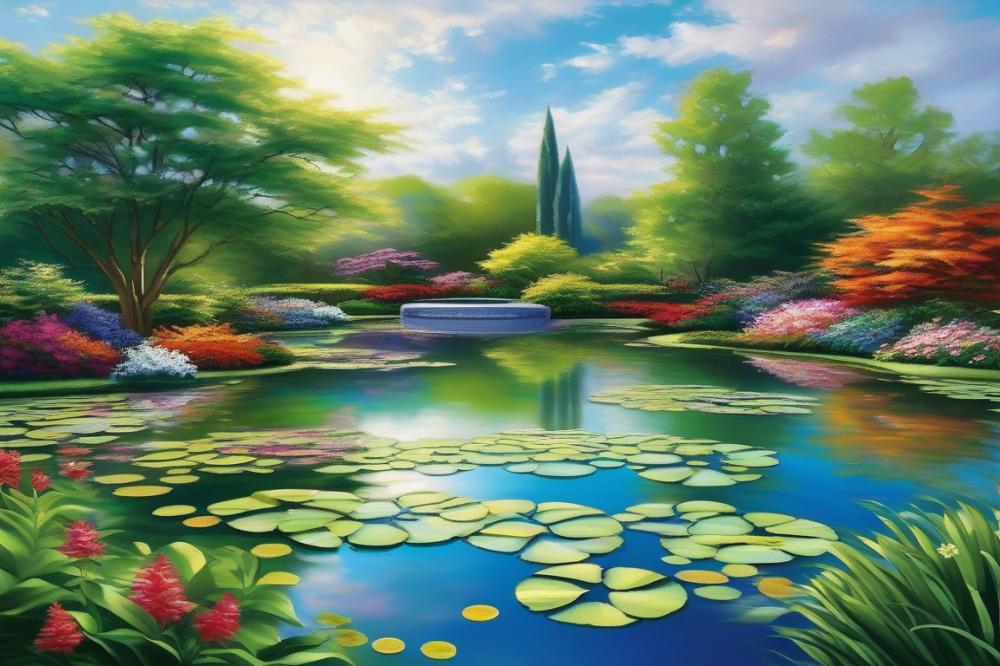Creating a Japanese tea garden: A Step-by-Step Guide
Japanese tea gardens have a rich history and cultural significance. These landscapes offer much more than a beautiful view; they provide a space for reflection and communion with nature. Often, people seek these gardens for their ability to promote zen and tranquility. The carefully designed elements work together to foster an atmosphere of peace, making them ideal spots for tea ceremonies and quiet contemplation.
Essential components include stones, water features, and plants. Each of these elements serves a purpose. Pathways meander through the garden, inviting visitors to explore and feel connected to the space. Bonsai trees, prized for their intricate beauty, add to the overall harmony of the landscape. These features are not just decorative; they symbolize deeper meanings embedded in Japanese culture.
This guide aims to help readers create their own serene environment. Step by step, we will cover the various elements needed for effective garden design. From choosing the right plants to placing stones thoughtfully, every detail counts. By the end, you will have the knowledge to craft a space that embodies tranquility and invites reflection. Embrace the journey of creating your own personal sanctuary.
Understanding the Elements of a Japanese Tea Garden
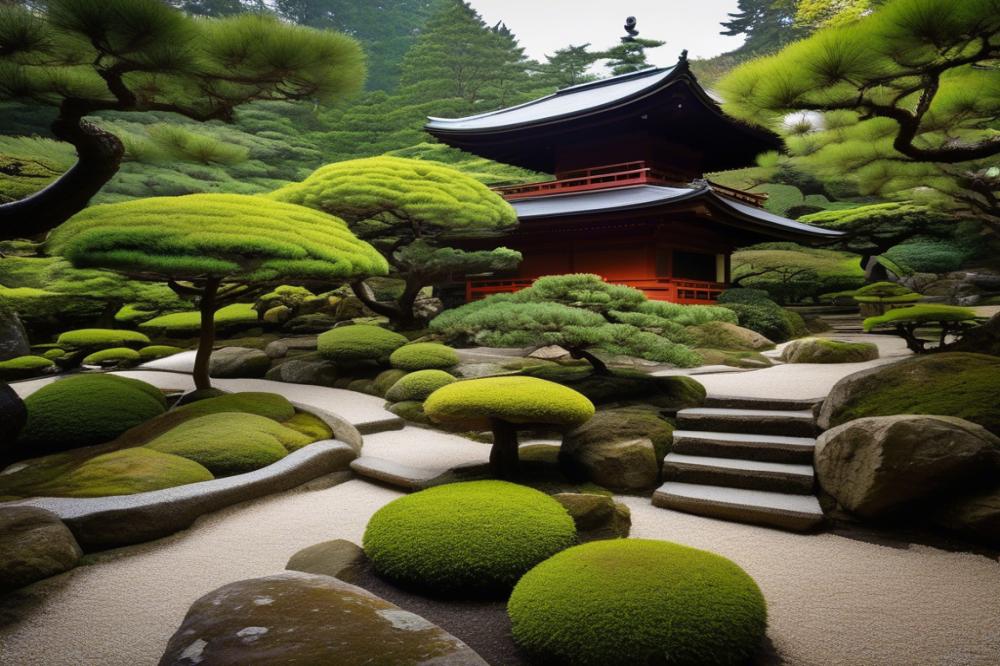

Creating a serene space requires an appreciation for the unique characteristics of a tea garden. This type of garden is not simply about planting flowers. It embodies the Japanese philosophy of zen and tranquility. It serves as a retreat from the hustle and bustle of everyday life. Every detail contributes to a harmonious landscape that promotes relaxation.
Key Components: Plants, Stones, Pathways, and Water Features
Several key components come together to form a balanced environment. Plants play a crucial role in setting the mood. Varieties such as bonsai, bamboo, and flowering shrubs offer beauty and depth. Different colors and textures enhance the scenery. Meanwhile, stones are often used for pathways and arrangements. They provide structure and stability to the garden. Choosing natural stones allows for a more organic feel, connecting visitors to the earth.
Water features, like ponds or small streams, add to the overall experience. The sound of trickling water creates a calming atmosphere. Reflective water surfaces can bring a sense of peace, drawing the eye and mind. Such elements work together to embody the spirit of the garden.
The Concept of Harmony in Design
Achieving harmony in design is at the heart of this gardening style. Every element should feel integrated and cohesive. This involves careful planning and placement of each component. Balancing all aspects—plants, stones, pathways, and water—is essential. It reflects the interconnectedness of nature.
Cultural significance is also vital in this kind of garden. Each element has meaning and purpose. By honoring traditions, creators can respectfully connect with the rich history surrounding Japanese gardening. This makes the resulting landscape not just beautiful but meaningful too.
Selecting the Right Location and Design


Choosing the right landscape for your garden is crucial. A setting that captures the essence of zen can greatly influence the atmosphere. Look for spaces that feel serene and offer privacy. Consider areas with natural slopes or gentle contours. These features can add character to the design.
Planning the layout requires careful thought. Start by sketching a basic outline. Pathways will guide visitors through the garden, encouraging exploration. Incorporating a tea house provides a central gathering point. This space can enhance the communal spirit of the garden, promoting harmony.
Seating areas are just as important. They allow visitors to pause and enjoy the tranquility of the surroundings. Position benches or stone seating amidst lush plants and bonsai trees. These spots should be shaded to create a peaceful retreat.
Natural features can greatly enrich your project. If there are existing stones or trees in the landscape, work with them. Water features, such as small ponds or streams, can bring a calming element. The sound of flowing water creates a serene atmosphere that many seek in a garden.
When selecting plants, aim for varieties that thrive in your climate. Choose each species with care to achieve a balanced look. The goal is to create a tapestry of colors and textures. This enhances the garden’s cultural significance and reflects traditional Japanese aesthetics.
Think about how everything fits together. Each element should work in unison to create an oasis of tranquility. By carefully considering location and design, you can craft a space that invites peace and reflection, engaging visitors in the beauty of nature.
Choosing Plants and Trees
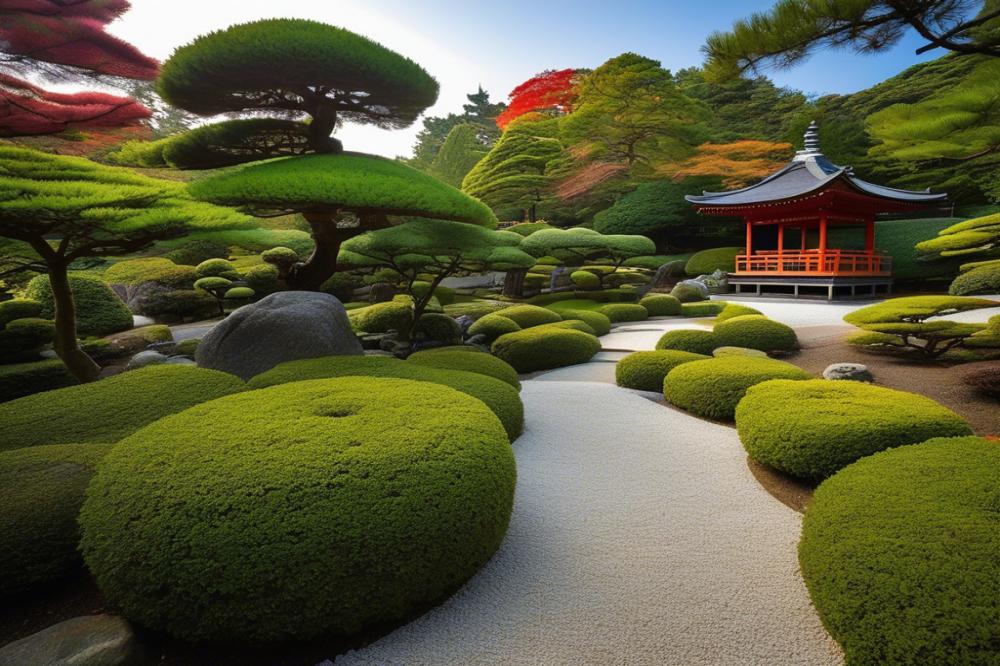

When designing a Japanese tea garden, selecting the right plants is crucial. Various species embody the essence of tranquility and play a significant role in the overall landscape. For this purpose, consider integrating evergreens like Japanese black pine and holly. These trees provide year-round greenery and a natural framework for your space.
Recommended Plants for a Japanese Tea Garden
In addition to evergreens, flowering plants like cherry blossoms and azaleas are ideal. These colorful additions create a striking contrast, especially in spring when nature blooms vibrantly. Bamboo can also be a stunning feature, offering a unique texture and height that draws the eye upward.
The Role of Bonsai in Creating Harmony and Finesse
Bonsai contributes significantly to a tea garden’s zen atmosphere. This miniature art form showcases the beauty of nature on a smaller scale, promoting a sense of calm. A carefully arranged bonsai tree can become a focal point, symbolizing harmony and meticulous care.
Seasonal Considerations and Plant Placement
Seasonality must influence plant placement for a dynamic landscape. Some plants offer visual interest during specific times of the year. For instance, maples display stunning foliage in autumn, while evergreens maintain their elegance through winter.
Paths should zig-zag between trees and plants, allowing visitors to explore the garden fully. Strategic placement of water features, like small ponds or fountains, can enhance the peaceful atmosphere. Surrounding these features with stones adds texture and contrast, enriching the sensory experience.
When planning your garden, think about the cultural significance of each element. Traditional Japanese gardens emphasize balance and serenity. Therefore, choosing the right mix of plants creates a tranquil environment that invites reflection.
Incorporating Water Features and Stones
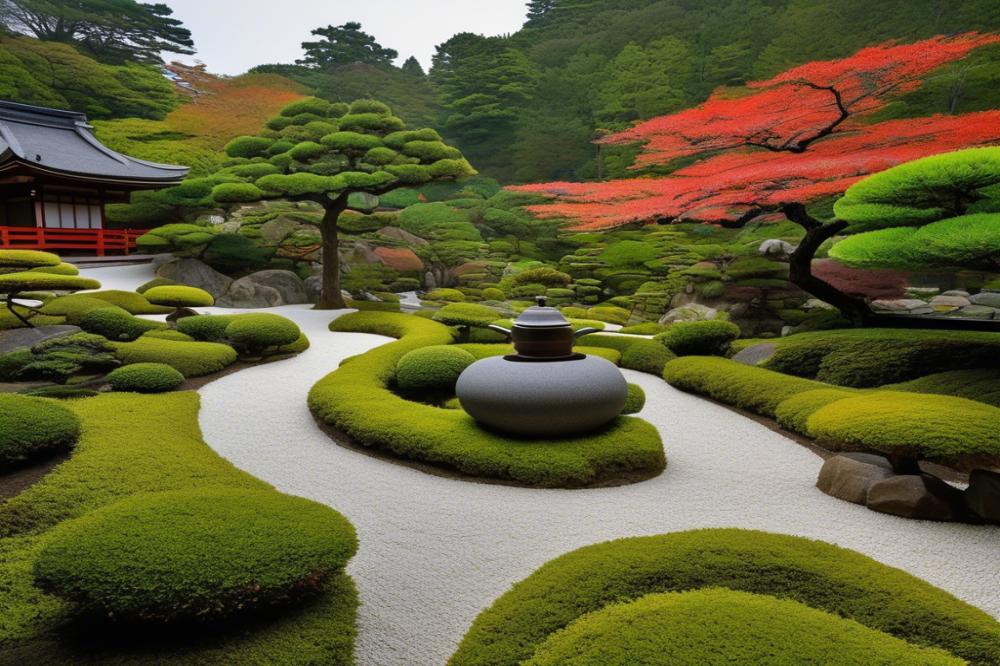

Water features are essential elements of a Japanese tea garden. They bring both beauty and a sense of zen. Ponds, streams, and waterfalls can create a soothing atmosphere, promoting tranquility. For instance, a pond can serve as a focal point. Surrounding it with small plants enhances the landscape. Add koi fish for movement and color. Streams can weave through the garden, guiding visitors along. These flowing elements mimic nature and echo the essence of life.
Stones also hold great cultural significance in Japanese gardens. They symbolize stability and endurance. Their placement can influence the garden’s balance. Rocks should be chosen carefully, considering shape and size. Additionally, they add texture and contrast to softer plants. Arranging stones in groups can create a natural look. Large boulders can act as visual anchors, while smaller stones can fill open spaces. Together, they work with water features to create harmony.
Building Pathways and Seating Areas
Pathways guide visitors through the space. Using stones for pathways adds a rustic charm. These surfaces can create an inviting feeling. Pathways can also reflect the garden’s layout. A winding path encourages exploration. Add stepping stones to break up long stretches. Seating areas, often made from benches or larger stones, invite relaxation. Choose locations with views of water features for optimal enjoyment.
Consider incorporating bonsai plants along the pathways. They represent the art of cultivation. Their small size makes them perfect for intimate seating areas. Use stones to form borders around these plants. This creates clear lines that enhance the garden’s design. A well-placed stone bench can become a peaceful retreat. Guests can take time to absorb the scenery and reflect on the beauty around them. Ultimately, combining these elements of water and stone fosters a serene environment, allowing everyone to connect with nature.
Creating the Right Atmosphere
To cultivate a sense of zen in your garden, focus on design elements that promote tranquility. Soft lines and organic shapes define the landscape. Curved pathways guide visitors gently through the space. Incorporating stones adds texture, while water features augment the soothing sounds of nature.
Sound plays a vital role in setting the mood. The subtle trickling of water can drown out noise from the outside world. Consider adding a small fountain to provide a calming auditory experience. Birds and rustling leaves can enhance this effect, creating a peaceful retreat from the everyday hustle.
Scent also contributes to the overall experience. Aromatic plants, such as jasmine or mint, invite relaxation and stimulate the senses. Their fragrance lingers in the air, helping to transport visitors into another realm. Many people associate certain scents with memories, making the space feel more personal and inviting.
Selecting decor and artifacts that reflect cultural significance can deepen the experience. Look for bonsai trees, which symbolize patience and care in Japanese culture. Lanterns, often made of stone or wood, provide subtle lighting while adding to the garden’s aesthetics. Each element should tell a story, reinforcing the harmony of the space.
Incorporating unique items further blends tradition with your vision. Authentic Japanese tea sets, positioned near seating areas, can inspire quiet moments of reflection. Ensure that each piece complements its surroundings without overwhelming the natural beauty of the plants and stones.
Maintaining Your Japanese Tea Garden
Maintenance is essential for any garden, especially one inspired by Japanese traditions. Plants and features require regular attention. Regular pruning keeps foliage neat and promotes healthy growth. Water features should be checked often. Stagnant water can become a breeding ground for pests. Clean stones and pathways as dirt can detract from the overall landscape. Take the time to inspect your bonsai trees, as they also need careful shaping.
Seasonal Care
Every season brings different tasks. In spring, plant new flowers and herbs. Summer is a time for weeding and watering. Fall provides an opportunity to admire autumn colors. Collect fallen leaves but leave some as mulch. Winter maintenance requires wrapping plants for protection against frost. Inspect stones and pathways regularly to prevent any wear or damage.
Reflection and Mindfulness
Maintaining a garden is more than just work; it’s a practice in mindfulness. Each moment spent tending to plants brings tranquility and harmony. To achieve the zen-like atmosphere, take time to reflect while you work. Observe how the landscape changes with the seasons. Let thoughts flow freely as you prune or rake. Through continuous engagement, one can find peace and appreciation in each procedure. The cultural significance of this practice deepens your connection to nature.
Final Thoughts on Your Japanese Tea Garden Journey
Creating a Japanese tea garden involves several thoughtful steps. Start by selecting the right location, emphasizing both privacy and natural beauty. Once you’ve chosen a spot, design the layout carefully. Consider adding paths, water features, and plants that inspire a sense of peace. Each element should contribute to the overall harmony of the space.
Appreciating this process is just as vital as the garden itself. This landscape is not just about aesthetics; it holds deep cultural significance. The tea garden embodies principles of zen, encouraging visitors to slow down and reflect. Your garden can become a personal sanctuary, a space for mindfulness and connection to nature.
Sharing the tranquility of your garden can be just as rewarding. Invite friends and family for a tea ceremony or simply to enjoy the beauty of your creation. They, too, can experience the calmness that your garden offers. Remember, this journey is as important as the destination. Enjoy every moment spent planning, planting, and watching your vision come to life.
In closing, embrace the lessons learned while designing this serene space. Let your garden be a reflection of your commitment to peace and balance. Ultimately, it will serve not just as a visual retreat, but as a daily reminder of the beauty surrounding you.

